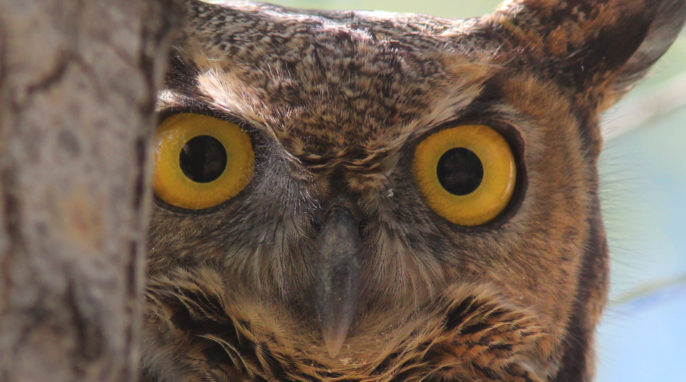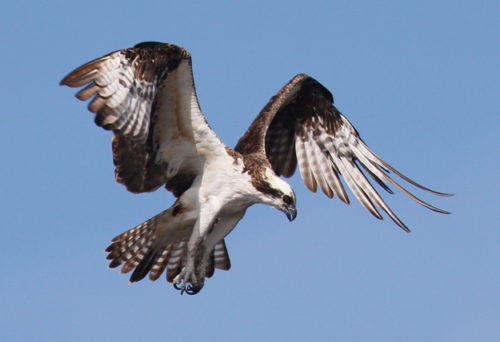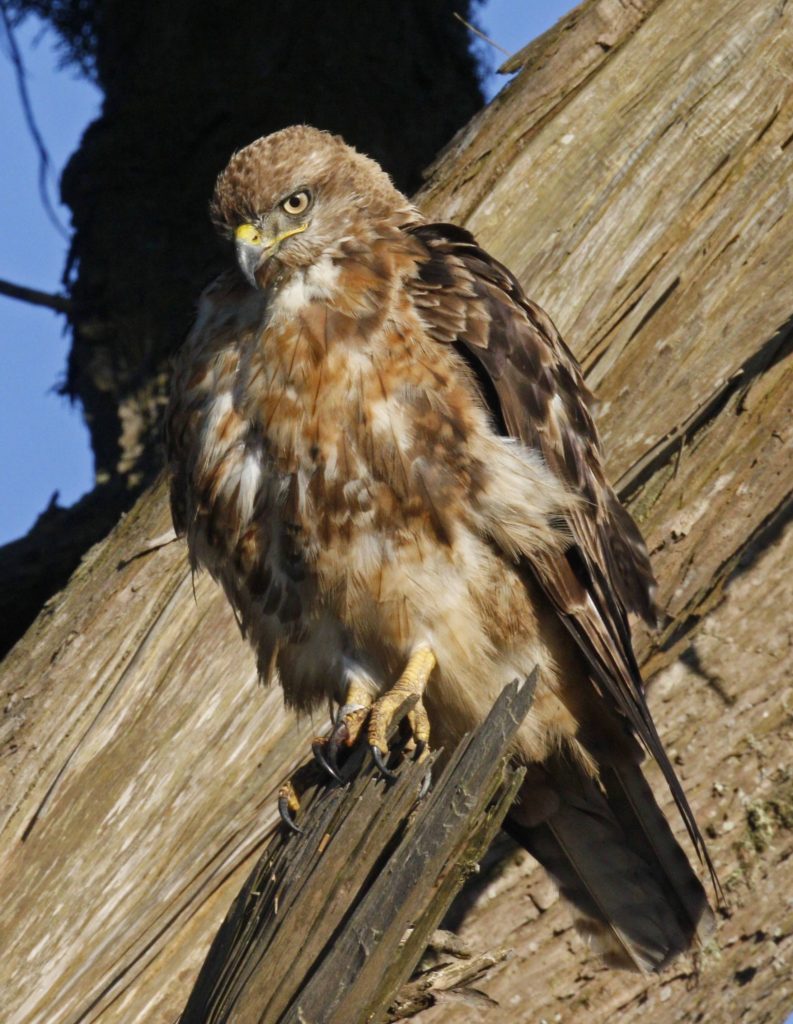Bird Eyes: The Greatest Eyes on Earth
Bird eyes have incredible vision. Falcons and other birds of prey have highly specialized eyes for a predatory lifestyle on the wing.
Powered flight has arisen independently on our planet a total of five times: in insects, pterosaurs, bats, birds, and, of course, human beings. A suite of highly specific characteristics is necessary for the defiance of gravity, from lightweight, lift-generating surfaces to precise sensing devices. But dragonflies and F-16s notwithstanding, nothing has conquered the skies quite like the bird.
For us—clever, indeed, but weak, fragile, and relatively blind—it should come as no surprise that the vision standards for becoming a US Air Force pilot are remarkably stringent: no color blindness, no abnormal refraction or accommodation issues, and corrected 20/20 vision. In order to fly a jet, a strong and responsive visual system is absolutely paramount, because a single mistake in judging distance, depth, or timing could spell instant death. This also applies to flight in the animal kingdom, where the unforgiving demands of flight have led to an astonishing diversity in form, function, and style.
Nowhere is this more apparent than in bird eyes, which have adapted to a dazzling array of niches, habits, and lifestyles. An F-16 weighs close to 20,000 lb and can achieve Mach 2 at altitude. This incredible speed is controlled not just by a thinking human but by a suite of sophisticated instrumentation, including pitch controls, stabilizers, and radar. A real falcon, by contrast, can hit 200 mph in a dive and only weighs about 2 lb. But a falcon’s instrumentation, no less sophisticated, exists entirely within the confines of its neural circuitry, an enormous amount of which is devoted to the eyes. The visual apparatus of a bird represents the most elaborate, the most acute, and the most versatile of any eyes on the planet, and it’s one of the many adaptations for flight that has made the group so successful.
RELATED: WHY ARE EGGSHELLS SO STRONG?
Falcons and other birds of prey represent the upper end of what seems possible for animal vision, and their eyes are highly specialized for a unique predatory lifestyle on the wing. But this specialization must be based around a common model.
The Vertebrate Eye
All vertebrate eyes descend from a common ancestor, and most of them share a number of basic qualities. Bird eyes, like ours, function by admitting light through the transparent cornea, lens, and vitreous body to stimulate photoreceptors on the retina at the back of the eye. Each retina has at least one fovea, a densely packed concentration of photoreceptors that’s responsible for sharp central vision. These receptors are specialized neurons classically divided into rods and cones, named for their shape and adapted to handle the value and color, respectively, of our visual environment. These receptors translate light energy into neural impulses by the differential bleaching of photopigments. Cone cells, for example, transduce photons into neural impulses via three classes of photopigments—called photopsins—each of which absorb a different range of light wavelengths.
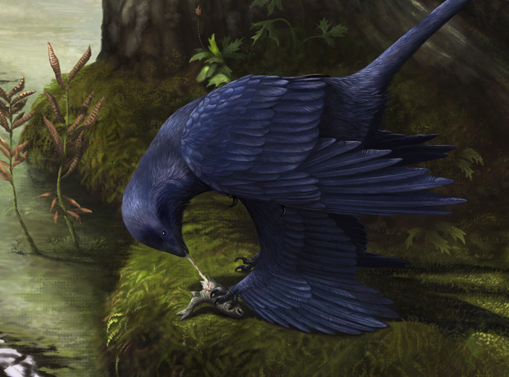

This three-part sensitivity results in millions of combinations that we perceive as colors, not unlike the way in which computer monitors may display images based only on the axes of red, green, and blue. The “perception” part of vision doesn’t begin until these neural impulses, coded as cascades of electrical signals, travel from the retina to the brain. Since eyes can contain an extraordinary number of photoreceptors and they can’t all connect directly to the optic nerve, receptors are connected by a smaller number of ganglion cells, which pool visual input and transfer the consensus along to the optic nerve and onward to the brain. This model of the visual system takes on countless tweaks throughout the vertebrate lineage, but these basics are largely consistent.
Before Birds Were Birds
Birds are archosaurs—the group of diapsid amniotes that includes crocodiles, pterosaurs, and dinosaurs—and these split off from the rest of the reptile lineage by the early Triassic, around 250 million years ago. Birds would therefore be expected to share features of the visual system with reptiles that they don’t share with mammals, and indeed they do: most notably, birds and reptiles both have four types of color receptors (cone cells) in the eyes, rather than three, as in mammals. This enables them to perceive part of the ultraviolet spectrum of light, invisible to us, as well as to detect polarized light and even magnetic fields. Bird eyes also lack the spherical shape familiar to us in mammals—instead being flatter, allowing for a larger in-focus visual field—and are held immovable in their sockets by circles of bone called sclerotic rings, both traits shared with their reptilian brethren.
The archosaurian origin of birds has implications for the dinosaur visual system as well. While we can never expect the delicate soft tissue of eyes and brain to fossilize, we can observe that many of the smaller, bipedal carnivores had very large eye sockets, a binocular orientation, and sclerotic rings. Some of these bird-like carnivores have been subjected to color studies that examine the similarity between fossilized pigment cells and these cells in modern birds. In this way, we can predict their color pattern in life. Microraptor gui, for instance, was a small, four-winged dromaeosaur dinosaur that was probably glossy, shiny, and iridescent—a feature unlikely to evolve in an animal that can’t also see iridescence. We can be almost certain that these dinosaurs had vivid color vision, a prediction backed up both by phylogenetic bracketing and empirical fossil evidence. We have little indication, however, of unique adaptations in non-avian dinosaur vision, and even the least specialized of modern flying birds have extraordinary eyes.
Of Pigments, Perception, and Pigeons
“A pigeon is nothing else but two eyes with wings.” Rochon-Duvigneaud’s quote from 1943 is a pithy summary of how even the commonest of birds is remarkably dependent on the visual system. Pigeons outperform humans in their ability to discriminate differences in color (Emmerton & Delius 1980) and luminance (Hodos et al. 1985). Their visual perception is similarly impressive: a pigeon is capable of acquiring visual concepts of “animals” (Roberts & Mazmanian 1988) and “same vs. different” (Wright et al. 1988).
Pigeons share many of these abilities with other birds. Since increasing the anterior focal length generally maximizes visual acuity, it’s no surprise that birds have the largest eyes on average of any animal group. Even the flightless ostrich has an axial length of 50 mm (2 in), which gives it the largest eye of any land vertebrate (Walls 1942). With a larger eye, the optical image can be spread over greater retinal surface and therefore over more photoreceptors. The incredible density of these light-sensitive rods and cones is a major feature of bird eyes: for example, human eyes have about 200,000 receptors per square millimeter (mm2), while a tiny house sparrow has 400,000, and many birds of prey have over a million. In addition, a large number of nerve ganglia means that receptor input doesn’t have to be pooled as much, and many birds therefore have a much lower retinal convergence ratio than many animals.
Birds and living reptiles share another feature that likely predates their evolutionary split: the presence of colored oil droplets within the cone cells. These provide a protective shield against UV light but also serve to increase the reception of visual pigments by acting as tiny lenses which focus light onto the photoreceptors. The concentration and mixture of carotenoids—a type of pigment derived from chloroplasts—is largely responsible for the existence of at least five different colors of oil droplets across all birds (Varela et al. 1993). By varying the combination of oil droplets and cone pigments, a bird can have a greater range of spectral sensitivity, which is found to be reflective of the bird’s niche. Here, again, pigeons fare remarkably well, with very high UV sensitivity in the yellow field and excellent UV pattern discrimination (Remy & Emmerton 1989).
Bird eyes also tend to have impressive foveae—that densely-packed pit of cone cells at the back of each retina—though their size, orientation, and number varies greatly across species. Humans and other primates only have one fovea per eye, and their binocular overlap is what we rely on for things like reading. Many birds, including pigeons, however, have two distinct fovea per eye. This enables them to have multiple areas of maximally sharp vision.
Why do pigeons have such remarkable eyes? One answer is simply that all birds do: in order to fly, even clumsily, an animal must have excellent vision to navigate a fast-paced environment. But pigeons are no clumsy fliers. They are fast, agile, and highly streamlined, and their vision reflects their aerial prowess. To see why, we can look to the predators that drove their evolution—a group which happens to include the fastest animals on earth.
Eyes like a Hawk
Birds of prey, or “raptors,” are loosely defined as predatory birds that use their feet to kill. This group may include hawks, eagles, vultures, ospreys, owls, and falcons, not all of which have a single evolutionary origin (making the group paraphyletic). Raptor vision is legendary and has been shaped primarily by the pressures of prey pursuit and capture. Some of these adaptations are obvious, such as the enormous relative size of raptor eyes—approximately 1.4 times greater than average for same-size birds—and a binocular orientation of bird eyes.
Other adaptations are seen on the cellular level. Multiple foveae are hallmarks of diurnal birds of prey, many of whom must combine panoramic sight with stereoscopic vision for attacking prey directly from flight. The ganglion cell density at the foveae of some of these predators can reach up to 65,000 per mm2. Humans, by contrast, have a foveal density of around 38,000 mm2 (Curcio & Allen 1990) and, of course, only one fovea. These raptors also have an exceptionally low retinal convergence ratio, meaning that the photoreceptors don’t have to share as many nerve fibers as is typical, even for birds. In other words, birds of prey tend to have an extremely large number both of photoreceptors and ganglion cells, which maximizes visual resolution.
Still other adaptations involve the complex interaction of several working parts. For example, the shape of the deep central fovea may itself be able to increase the size of the retinal image (and therefore the spatial resolution) independently from the number and spacing of photoreceptors. This shape—consisting of a spherical depression in the fovea—acts roughly as a negative lens component as seen in telephoto lenses (Snyder & Miller 1978).
The astonishing visual acuity of hawks, falcons, eagles, and their kin comes at a cost. Diurnal birds of prey, with their cone-rich retinae and very low convergence ratios, must trade off brightness sensitivity as a consequence. As light intensity decreases, raptor vision loses its edge—and in very low light, their niche is overtaken by their silent, nocturnal brethren.
Owl You Need Is a Lot of Rods
To look into the eyes of an owl is to know, immediately, that there’s something special about them. Most obvious is their size: they are vast, even for birds of prey, at 2.2 times the average size of same-sized birds. They are also strikingly binocular, with a 50-70% field overlap (compare to a 30-50% overlap in diurnal birds of prey). Few owls have multiple foveae; instead, their retinae are packed even more densely with photoreceptors than their diurnal (daytime) relatives, with close to 60,000 receptors per mm2.
Owl eyes, unlike other bird eyes, have very few cone cells, which respond poorly in low light. Instead, their 60,000 receptors are mostly all rods. But because rod cells only contain one type of photopigment (called rhodopsin) instead of three, they cannot transduce color by combined activation. Instead they are vastly more responsive to the presence of light through a process of signal amplification, wherein a single unit of rhodopsin can lead to a large and fast cascaded reaction. In this way, rod cells can respond to a very small number of photons.
On top of their breathtaking retinal rod density, owls also have a structure called the tapetum lucidum taking the place of colored oil droplets. This iridescent structure lies behind the retina, and it works by reflecting light back through the retina along the light path, thereby making a limited number of photons available to photoreceptors for a sort of “second attempt” at activation. This greatly increases the amount of light available to the rod cells. This structure, which is a nocturnal adaptation found in a variety of animals, is most readily observable in cats.
A Kingdom of a Thousand Bird Eyes
This brief overview fails to capture the latitude of diversity in visual adaptations among birds, but proper treatment would take a book or more. From terns and their deeply-colored oil droplets to the bizarre narrow range of retinal sensitivity specific to shearwaters and petrels, seabirds, especially, have a number of complex adaptations to handle the behavior of light on the ocean. Diving birds like auks and loons have flexible lenses and use their transparent nictitating membrane (eyelid) as a second lens, allowing for greater optical accommodation. Penguins have taken a different path by evolving extremely strong lenses to compensate for a flat cornea adapted to swimming underwater.
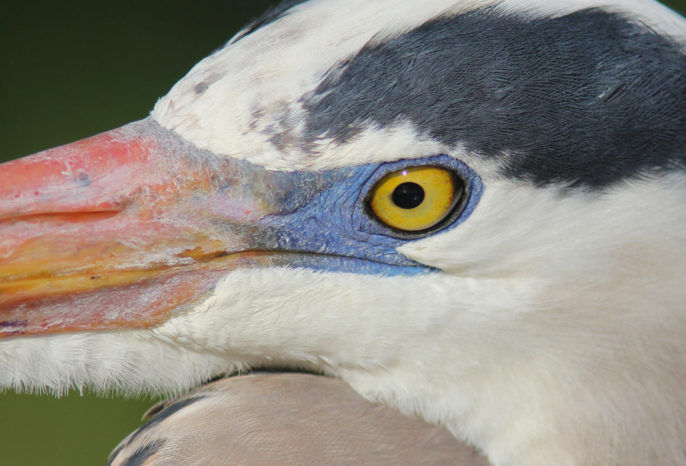

Where the structure of the eye itself fails to adapt, perception, learning, and instinct may come into play. Hawks and other fast-moving birds can resolve rapid movement exceptionally well, and even a chicken can detect the oscillation of a flickering light bulb at over 100 hertz (Hz), about double what’s possible for humans. Many herons and egrets are able to compensate for the effects of light refraction on water by striking at aquatic prey from an acute angle. Migratory birds can perceive magnetic fields with the help of photoreceptive proteins called cryptochromes, which produce tiny electrical charges that interact with the Earth’s magnetic field. How, exactly, they derive and process the information they use to navigate is still largely mysterious.
In many ways, the avian lineage represents the almost unbelievable extremes of evolution. No other group of animals can move as fast, soar as high, fly as far, or see as well as birds. Even we, with the cameras, telescopes, and flying machines produced by uniquely enlarged frontal lobes, cannot yet emulate the breadth and depth of the abilities that birds have evolved. An F-16 can fly at twice the speed of a moving sound wave, but it cannot pull up from a dive mere inches from the ground as a real falcon can. Our sophisticated instruments can tell us where to find UV waves, magnetic lines, and a handful of photons in utter darkness, but they cannot do so with a millisecond flick of a synapse. We still have much to learn.
All images © Emily Willoughby

